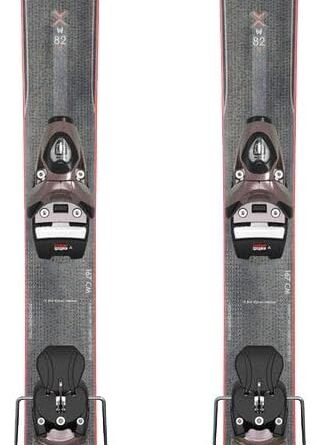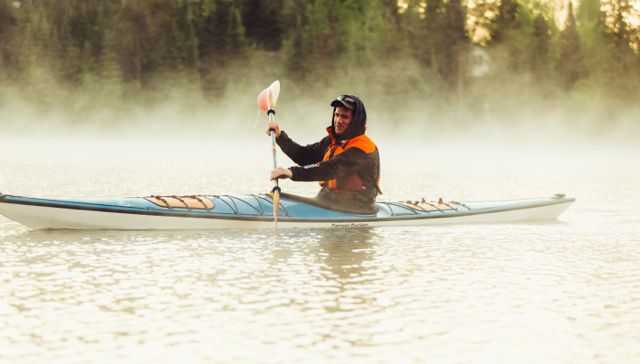
Are you ready to embark on an exciting sea kayaking adventure? Before you hit the open water, it’s crucial to select the perfect kayak paddle that suits your needs. With a plethora of options available, finding the ideal size and style can be overwhelming. However, fear not! This comprehensive guide will provide you with all the information you need to make an informed decision. From understanding the importance of paddle length to exploring different blade shapes, we’ll help you choose the perfect paddle that will enhance your sea kayaking experience. So, let’s dive right in and navigate the waters with confidence!
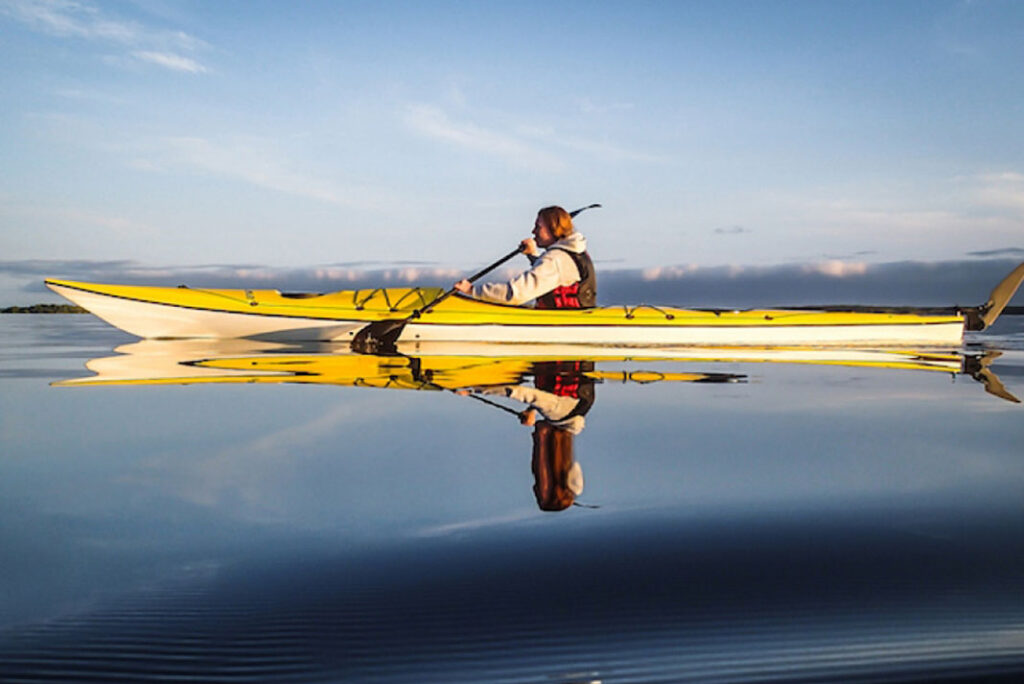
This image is property of paddlingmagazine-images.s3.amazonaws.com.
Types of Kayak Paddles
When it comes to choosing a kayak paddle for sea kayaking, one of the first decisions you’ll need to make is the type of paddle you prefer. There are three main types to consider: low-angle paddles, high-angle paddles, and wing paddles.
Low-Angle Paddles
Low-angle paddles are great for those who prefer a more relaxed paddling style. These paddles are designed to be used with a low-angle stroke, where the blade stays close to the water throughout the stroke. They offer a smooth and easy paddling experience, making them well-suited for long-distance paddling or leisurely trips on calmer waters.
High-Angle Paddles
If you’re looking for a more aggressive and powerful paddling style, high-angle paddles might be the right choice for you. These paddles are designed for a higher-angle stroke, where the blade is lifted higher out of the water during the stroke. High-angle paddles are more efficient and provide greater control, making them ideal for rougher conditions or for paddlers who prioritize speed and maneuverability.
Wing Paddles
Wing paddles are a specialized type of paddle that is commonly used in competitive kayaking. They have a unique blade shape that resembles a wing, which allows them to cut through the water with minimal resistance. Wing paddles are designed for high-intensity, high-angle paddling and are typically used by experienced paddlers or those looking to improve their speed and performance.
Factors to Consider
Before diving into the specifics of paddle length, blade size, and materials, it’s important to consider several factors that will affect your paddle choice. These factors include your height, the width of your kayak, your paddling style, your experience level, and your grip style.
Kayaker’s Height
Your height plays a significant role in determining the proper paddle length for you. Taller kayakers will generally require a longer paddle to ensure proper reach and efficiency, while shorter kayakers may opt for a shorter paddle to avoid excessive strain or discomfort.
Kayak Width
The width of your kayak is another crucial factor to consider when selecting a paddle. A wider kayak will require a longer paddle to reach the water comfortably, while a narrower kayak may necessitate a shorter paddle for optimal performance.
Paddling Style
Your preferred paddling style will also impact your choice of paddle. If you enjoy a more relaxed and leisurely paddling experience, a low-angle paddle may be ideal. Conversely, if you prefer a more aggressive and powerful stroke, a high-angle paddle may be more suitable.
Experience Level
Your experience level is an essential consideration when choosing a kayak paddle. Beginners may benefit from a paddle with a larger blade surface area, as it provides more power with each stroke. Advanced paddlers, on the other hand, may prefer a paddle with a smaller blade for increased maneuverability and efficiency.
Grip Style
Your grip style is another factor to keep in mind. There are two primary grip styles: a straight shaft and a bent shaft. A straight shaft offers a more traditional grip and is suitable for most paddlers. A bent shaft, on the other hand, provides a more ergonomic grip that can help reduce wrist and arm fatigue on longer paddling trips.
Selecting the Correct Length
Now that you’ve considered the various factors that will influence your paddle choice, let’s delve into the specifics of selecting the correct paddle length for your needs. The length of your paddle will affect your reach, stroke efficiency, and overall paddling experience.
Low-Angle Paddling Length
For low-angle paddlers, the general rule of thumb is to choose a paddle length that is roughly the same as your height. This will provide you with the proper reach and allow for efficient and comfortable paddling.
High-Angle Paddling Length
High-angle paddlers typically prefer a slightly shorter paddle. A paddle length that is approximately 8 to 10 inches shorter than your height is a good starting point. However, personal preferences and paddling style may influence the final choice of paddle length.
Wing Paddling Length
When it comes to wing paddles, the proper length is highly dependent on your specific style and technique. It is recommended to consult with an expert or experienced paddler who can guide you in selecting the ideal wing paddle length for your needs.
Understanding Blade Size and Shape
The size and shape of the blade on your kayak paddle will also have a significant impact on your paddling experience. Understanding the concepts of blade surface area, shape, and material will help you make an informed decision.
Blade Surface Area
The surface area of the blade refers to the total area of the paddle’s face that comes into contact with the water during each stroke. A larger blade surface area provides more power, making it suitable for beginners or those who prefer a more powerful stroke. Conversely, a smaller blade surface area offers increased efficiency and maneuverability, making it a popular choice among experienced paddlers.
Blade Shape
Blade shape plays a role in determining the paddle’s efficiency, stability, and maneuverability. There are various blade shapes available, including dihedral, flat, and asymmetrical. Each shape has its advantages and disadvantages, so it’s essential to try out different shapes to find the one that best suits your paddling style and needs.
Blade Material
The material used to construct the blade can impact its durability, weight, and performance. Common blade materials include fiberglass, carbon fiber, plastic, wood, and aluminum. Fiberglass and carbon fiber blades are lightweight and offer excellent performance, but they come at a higher cost. Plastic blades are more affordable but may not provide the same level of efficiency or durability. Wood and aluminum blades are typically less common but can offer unique characteristics for specific paddling preferences.

This image is property of cdn.shopify.com.
Materials Used in Kayak Paddles
In addition to the blade materials, the construction of the paddle shaft also plays a crucial role in the overall performance and durability of the paddle. Understanding the various materials used in kayak paddles will help you make an informed decision.
Fiberglass Paddles
Fiberglass paddles are a popular choice among paddlers due to their lightweight nature and excellent strength-to-weight ratio. They provide a good balance between performance, durability, and price, making them suitable for a wide range of paddlers.
Carbon Fiber Paddles
Carbon fiber paddles are at the top end of the spectrum in terms of performance. They are incredibly lightweight, providing optimal efficiency and reducing fatigue during long paddling trips. However, carbon fiber paddles tend to be more expensive, making them a better fit for advanced paddlers or those who prioritize performance over budget.
Plastic Paddles
Plastic paddles are an affordable option for recreational paddlers or beginners who are just starting their kayaking journey. While they may not provide the same level of performance or lightweight characteristics as fiberglass or carbon fiber paddles, they are durable and can withstand rough handling or accidental impacts.
Wooden Paddles
Wooden paddles are a timeless and traditional choice for paddlers who appreciate the aesthetics and feel of a natural material. They can provide a unique paddling experience and are often handcrafted for excellent quality. However, wooden paddles may be heavier than other materials and require more care to maintain their durability.
Aluminum Paddles
Aluminum paddles are known for their durability and strength. They are a budget-friendly option and can withstand harsh conditions or rough usage. However, they tend to be heavier than other materials, which may impact the overall performance and fatigue level of the paddler.
Evaluating Shaft Options
The shaft of a kayak paddle is the section that connects the blades to the handle, and it plays a crucial role in providing stability, comfort, and control. There are different types of shaft options available, each offering unique advantages and considerations.
Straight Shaft
A straight shaft is the most common type of shaft found in kayak paddles. It provides a traditional grip and is suitable for most paddlers. Straight shaft paddles are generally affordable and offer a comfortable and stable grip.
Bent Shaft
A bent shaft, also known as a crank shaft, offers a more ergonomic grip. It features a curve in the shaft that aligns with the natural position of the wrists, reducing strain and fatigue. Bent shaft paddles are a popular choice among paddlers who go on extended trips or those who have pre-existing wrist or arm issues.
Adjustable Shaft
An adjustable shaft allows you to change the length of your paddle on the go. This can be beneficial if you frequently paddle in different conditions or if you share your paddle with others who may require a different length. Adjustable shafts are often found in recreational paddles and can enhance versatility.
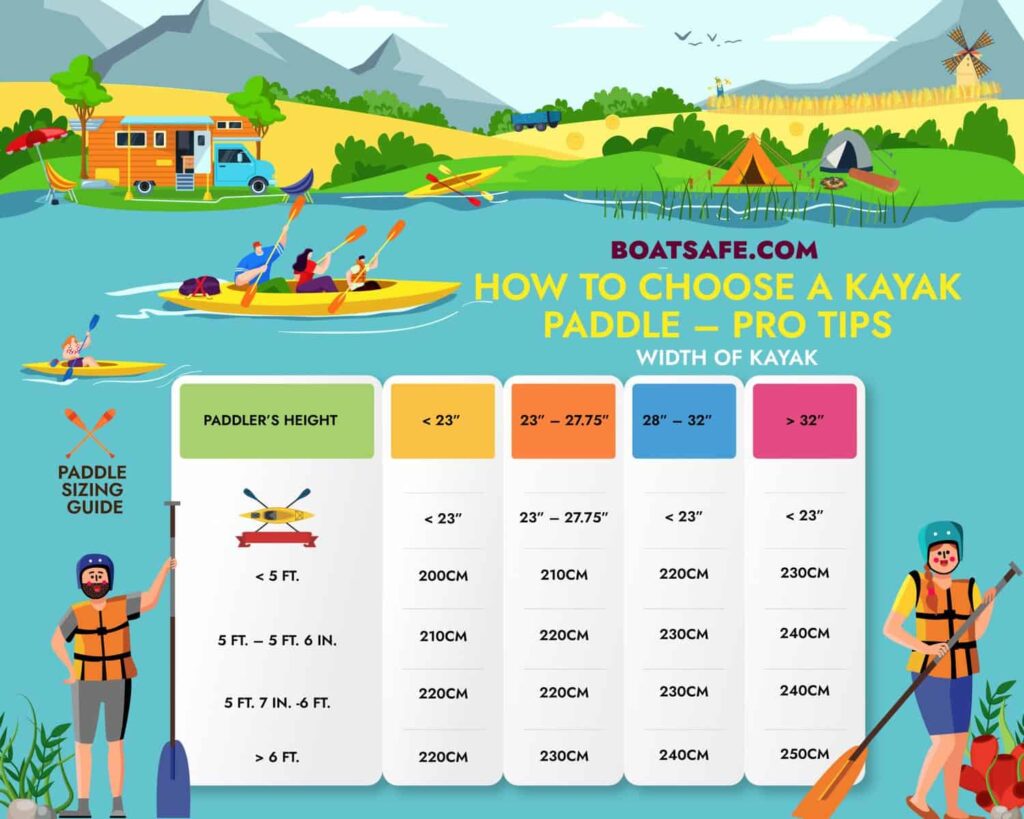
This image is property of www.boatsafe.com.
Paddle Weight Considerations
The weight of your paddle may not be the first thing that comes to mind when choosing a paddle, but it’s an essential factor to consider. The weight of the paddle can impact your paddling efficiency, overall experience, and level of fatigue.
Paddle Weight and Efficiency
A lighter paddle will generally be more efficient, allowing you to paddle longer without experiencing excessive fatigue. Lighter paddles are more maneuverable and provide quicker acceleration, making them suitable for those who prioritize speed and agility.
Effects of Paddle Weight on Fatigue
A heavier paddle may result in increased fatigue, especially during long paddling trips or in rough conditions. It requires more effort to lift, maneuver, and accelerate, which can lead to muscle strain or decreased paddling performance. If you anticipate frequent or extended paddling excursions, consider opting for a lighter paddle to minimize fatigue.
Considering Blade Feathering
Blade feathering refers to the angle between the two blades of a kayak paddle. Understanding the concept of blade feathering and its impact on your paddling style and comfort will help you make an informed decision.
Understanding Blade Feathering
Blade feathering allows for reduced wind resistance during paddling, especially when the wind is coming from the side or facing head-on. Feathered blades are offset at an angle, with one blade pointing into the wind while the other blade is minimized to reduce resistance.
Feathered vs. Unfeathered Paddles
Feathered paddles are more commonly used by experienced paddlers or those who often paddle in windy conditions. They provide improved control and reduced strain on the wrist and arm during each stroke. However, feathered paddles may require some adjustment and practice to find the optimal feather angle that suits your paddling style.
Unfeathered paddles have both blades aligned in the same plane, offering symmetrical resistance to the wind. They are often preferred by beginners or those who are unfamiliar with feathered paddles. Unfeathered paddles require less adjustment and are easier to use for paddlers who prefer simplicity.
Adjustable Feathering
Some paddles feature an adjustable feathering mechanism that allows paddlers to change the feather angle to suit their preferences and prevailing conditions. This can be beneficial if you regularly paddle in varying wind conditions or if you share your paddle with others who have different feathering preferences.
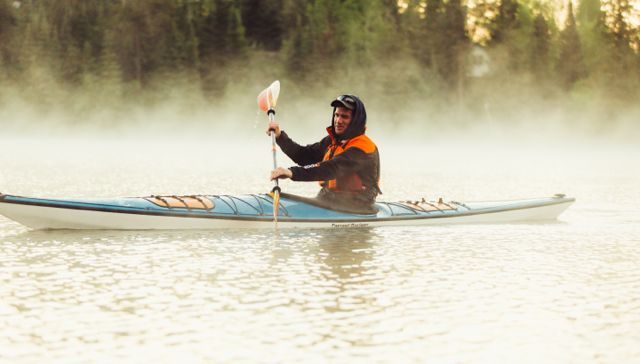
This image is property of cdn.shopify.com.
Testing the Paddle
Now that you have a good understanding of the different aspects to consider when choosing a kayak paddle, it’s time to put your knowledge to the test. Testing a paddle before making a purchase is highly recommended and can save you from potential disappointment or discomfort.
Demoing Paddles
Many kayak shops and outdoor retailers offer paddle demo programs, allowing you to try out different paddles on the water before making a final decision. Take advantage of these opportunities to get a feel for how different paddles perform and to determine which one suits your preferences and needs.
Renting or Borrowing
If you’re not quite ready to make a long-term commitment to a particular paddle, consider renting or borrowing paddles from friends or fellow paddlers. This will give you the opportunity to spend more time with the paddle and evaluate its performance in different conditions and over extended periods.
Seeking Expert Advice
If you’re still unsure about which paddle to choose, don’t hesitate to seek advice from experts or experienced paddlers. They can offer valuable insights, recommendations, and guidance based on their own experiences and expertise. Consider joining kayak clubs or communities to connect with fellow paddlers who can share their knowledge and help you make an informed decision.
Budget and Quality
Finally, when it comes to selecting a kayak paddle, it’s essential to find the right balance between your budget and the quality of the paddle. While high-end, high-performance paddles may be tempting, they may not be necessary for all paddlers.
Setting a Budget
Start by determining a realistic budget for your paddle purchase. Consider your own paddling goals, frequency of use, and overall budget for your kayaking gear. There are excellent paddles available at various price points, so finding one that meets your needs while staying within your budget is achievable.
Balancing Quality and Price
Remember that a higher price tag does not always guarantee a better paddle. While high-quality paddles may provide additional performance benefits, they may not be essential for beginners or recreational paddlers. Focus on finding a paddle that offers the right combination of quality, durability, and performance within your budget range.
By considering these various factors, testing different paddles, and seeking advice from experts, you’ll be well-equipped to choose the ideal size, style, and material for your sea kayaking adventures. Remember that the perfect paddle is the one that feels comfortable, efficient, and enjoyable for your personal paddling style and goals. Happy paddling!
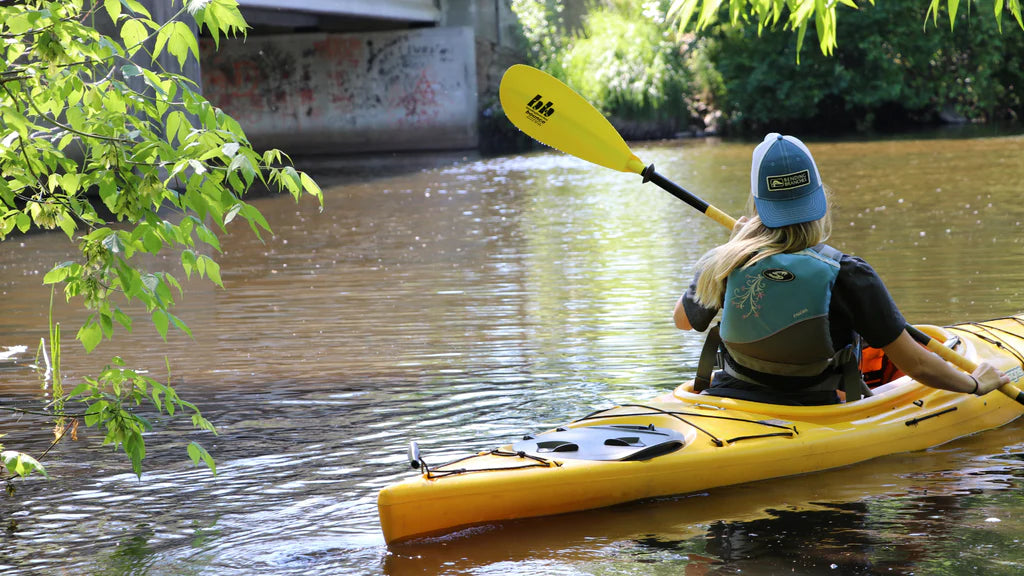
This image is property of festivewater.com.






